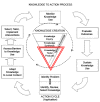Knowledge Translation Tools are Emerging to Move Neck Pain Research into Practice
- PMID: 24155807
- PMCID: PMC3805983
- DOI: 10.2174/1874325001307010582
Knowledge Translation Tools are Emerging to Move Neck Pain Research into Practice
Abstract
Development or synthesis of the best clinical research is in itself insufficient to change practice. Knowledge translation (KT) is an emerging field focused on moving knowledge into practice, which is a non-linear, dynamic process that involves knowledge synthesis, transfer, adoption, implementation, and sustained use. Successful implementation requires using KT strategies based on theory, evidence, and best practice, including tools and processes that engage knowledge developers and knowledge users. Tools can provide instrumental help in implementing evidence. A variety of theoretical frameworks underlie KT and provide guidance on how tools should be developed or implemented. A taxonomy that outlines different purposes for engaging in KT and target audiences can also be useful in developing or implementing tools. Theoretical frameworks that underlie KT typically take different perspectives on KT with differential focus on the characteristics of the knowledge, knowledge users, context/environment, or the cognitive and social processes that are involved in change. Knowledge users include consumers, clinicians, and policymakers. A variety of KT tools have supporting evidence, including: clinical practice guidelines, patient decision aids, and evidence summaries or toolkits. Exemplars are provided of two KT tools to implement best practice in management of neck pain-a clinician implementation guide (toolkit) and a patient decision aid. KT frameworks, taxonomies, clinical expertise, and evidence must be integrated to develop clinical tools that implement best evidence in the management of neck pain.
Keywords: Knowledge translation; implementation.; neck pain; tools.
Figures


References
-
- Sackett DL. Evidence-based medicine. Semin Perinatol. 1997;21(1):3–5. - PubMed
-
- MacDermid JC. An introduction to evidence-based practice for hand therapists. J Hand Ther. 2004;17(2):105–17. - PubMed
-
- MacDermid JC, Graham ID. Knowledge translation: putting the "practice" in evidence-based practice. Hand Clin. 2009;25(1):125–43. - PubMed
-
- Cote P, Kristman V, Vidmar M. The prevalence and incidence of work absenteeism involving neck pain: a cohort of Ontario lost-time claimants. Spine (Phila Pa 1976 ) 2008;33(4 Suppl ):S192–S198. - PubMed
-
- Cote P, van d V, Cassidy JD, Carroll LJ. The burden and determinants of neck pain in workers: results of the Bone and Joint Decade 2000-2010 Task Force on Neck Pain and Its Associated Disorders. Spine. 2008;33(4 Suppl ):S60–S74. - PubMed
LinkOut - more resources
Full Text Sources
Other Literature Sources
